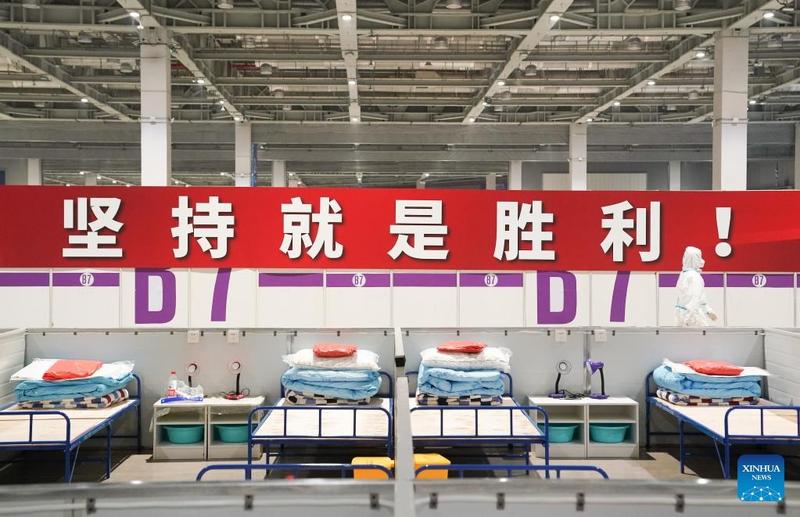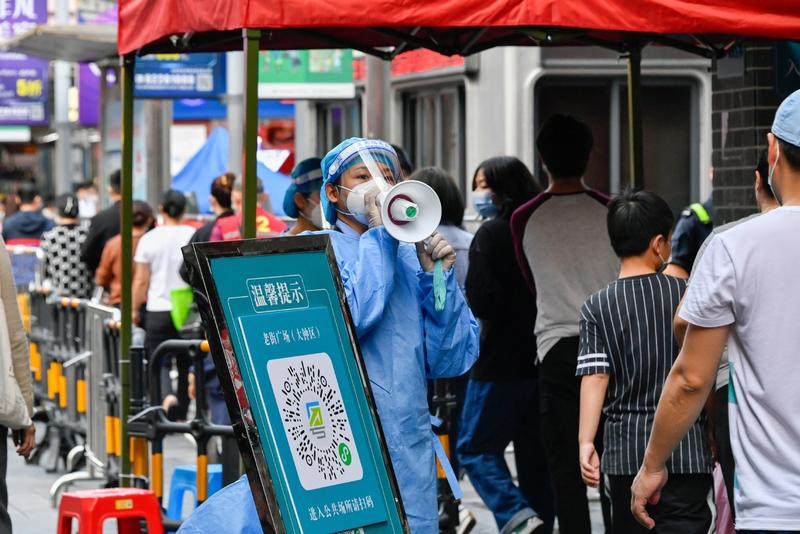 Medical workers check residents' information with a community staff member in East China's Shanghai, April 26, 2022. (PHOTO / XINHUA)
Medical workers check residents' information with a community staff member in East China's Shanghai, April 26, 2022. (PHOTO / XINHUA)
BEIJING – The Chinese government on Friday released a circular on further optimizing the COVID-19 response, announcing 20 prevention and control measures.
The circular stressed resolute efforts to put the people and their lives above everything else, practice the general strategy of "preventing both imported cases and domestic resurgences," and tenaciously pursue the general policy of "dynamic zero-COVID."
Optimizing and adjusting the COVID-19 response measures does not mean loosening prevention and control against the virus, still less a lift of COVID-19 restrictions or "lying flat" in the COVID fight, read the circular issued by the State Council joint prevention and control mechanism against COVID-19.
READ MORE: CPC leadership discusses optimizing COVID-19 response
The move was made to adapt to the new situation of COVID-19 prevention and control and the new characteristics of the virus mutations to make the response more targeted and science-based, maximize the protection of people's safety and health, and minimize the impact of the epidemic on economic and social development.
The categories of COVID-19 risk areas will be adjusted from "high", "medium", and "low" to "high" and "low" to minimize personnel under quarantine or health monitoring
The new measures include cutting the COVID-19 quarantine period for close contacts and inbound travelers, according to the circular.
Quarantine for the groups will be cut to five days of quarantine at designated sites plus three days of home quarantine, from the previous seven-day quarantine at designated sites plus three-day health monitoring at home.
Secondary close contacts will no longer be identified, the circular said.
Those who had visited the high-risk areas will be subject to a seven-day home quarantine instead of seven days of centralized isolation as previously required.
The categories of COVID-19 risk areas will be adjusted from "high", "medium", and "low" to "high" and "low" to minimize personnel under quarantine or health monitoring.
Those who had offered services at high-risk posts in areas under closed-loop management will undergo five days of health monitoring at home, instead of seven days of centralized isolation or seven days of home quarantine.
In regions with no infections, COVID-19 nucleic acid tests should be conducted among people working in high-risk positions or in key groups according to the ninth edition of China's COVID-19 control protocols, the circular said, adding that expanding test coverage is forbidden.
ALSO READ: Chongqing tussles with COVID
The country also canceled the circuit breaker mechanism for inbound flights, and the negative COVID-19 tests requirement for inbound travelers will be reduced from twice in 48 hours before boarding to once. Inbound important business travelers and sports groups will be directly transferred to closed-loop management areas, exempted from quarantine.
 This photo taken on April 11, 2022 shows the interior view of a makeshift hospital converted from the National Exhibition and Convention Center in East China's Shanghai. (PHOTO / XINHUA)
This photo taken on April 11, 2022 shows the interior view of a makeshift hospital converted from the National Exhibition and Convention Center in East China's Shanghai. (PHOTO / XINHUA)
For inbound travelers, those with cycle threshold values smaller than 35 in COVID-19 nucleic acid tests will be identified as positive cases, according to the document.
The circular required more efforts in enhancing medical resources and accelerating the reserve of drugs related to COVID-19 treatment.
Vaccination against COVID-19 should be advanced in an orderly manner, it said, adding that the coverage of booster vaccination should be stepped up, especially for the elderly.
ALSO READ: Guangzhou steps up virus fight
According to the document, the protection of key institutions and priority groups against the virus should also improve.
 A volunteer helps local residents register information and get in line for nucleic acid tests at a community in Shenzhen, March 13, 2022. (PHOTO / XINHUA)
A volunteer helps local residents register information and get in line for nucleic acid tests at a community in Shenzhen, March 13, 2022. (PHOTO / XINHUA)
The principle of early detection, reporting, quarantine, and treatment should be strictly observed to curb the scale and reduce the response time of the epidemic.
The document urged redoubling efforts to rectify one-size-fits-all approach and excessive policy steps, and to strengthen services to ensure those in quarantine have minimal interruptions to their lives.
READ MORE: Hard-hit areas vacated to lower further virus spread
It underscored the necessity to optimize COVID-19 prevention and control measures at campuses and to ensure that relevant control measures are fully implemented at enterprises and in industrial parks. It stressed the need to help those stranded to return home in an orderly manner.


